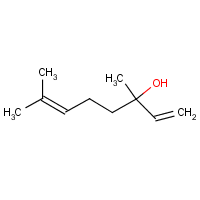Linalool
Agent Name
Linalool
Alternative Name
Linalyl alcohol
CAS Number
78-70-6
Formula
C10-H18-O
Major Category
Biological Agents

Synonyms
Linalyl alcohol; (+-)-Linalool; 1,6-Octadien-3-ol, 3,7-dimethyl-; 2,6-Dimethyl-2,7-octadiene-6-ol; 2,6-Dimethylocta-2,7-dien-6-ol; 3,7-Dimethyl-1,6-octadien-3-ol; 3,7-Dimethylocta-1,6-dien-3-ol; Linalool (natural); allo-Ocimenol; beta-Linalool; p-Linalool; [ChemIDplus]
Category
Plant Oils and Extracts
Description
Colorless liquid with an odor of bergamot oil or French lavender; [Hawley]
Sources/Uses
Main component of linaloe oil; Also found in oils of Ceylon cinnamon, sassafras, orange flower, and bergamot; [Merck Index] Found in citrus peel oils (especially orange); [Hawley] Used in perfumes, fragrances, flavoring agents, household cleaners, and insecticidal pet treatments; (direct application to pet and indoor area); [HSDB]
Comments
A skin and eye irritant; May cause liver injury; [ICSC] Emergency treatment: "Linalool"; A skin and eye irritant; [HSDB] Safe to use as a flavoring agent in food; [JECFA] Slight sedative effects after inhalation; Not a sensitizer; Not mutagenic; Causes effects on liver and kidneys in 28-day rat feeding study (72.9% linalool) with a NOAEL of 160 mg/kg/day; [OECD SIDS: Linalool - 2002] Included in list of "established contact allergens in humans"; [EC: Scientific Committee on Consumer Safety: Fragrance allergens in cosmetic products (2011)]
Biomedical References
Exposure Assessment
Vapor Pressure
0.16 mm Hg
Odor Threshold Low
1 ppm
Explanatory Notes
Olfactory threshold is approximately 1 ppm; [Reference #1]
NFPA
high ambient temp required
Adverse Effects
Skin Sensitizer
Yes
Neurotoxin
Acute solvent syndrome
Hepatotoxin
Hepatoxic (a) from occupational exposure (secondary effect) or (b) in animal studies or in humans after ingestion
Diseases, Processes, and Activities Linked to This Agent
Diseases
Occupational diseases associated with exposure to this agent: